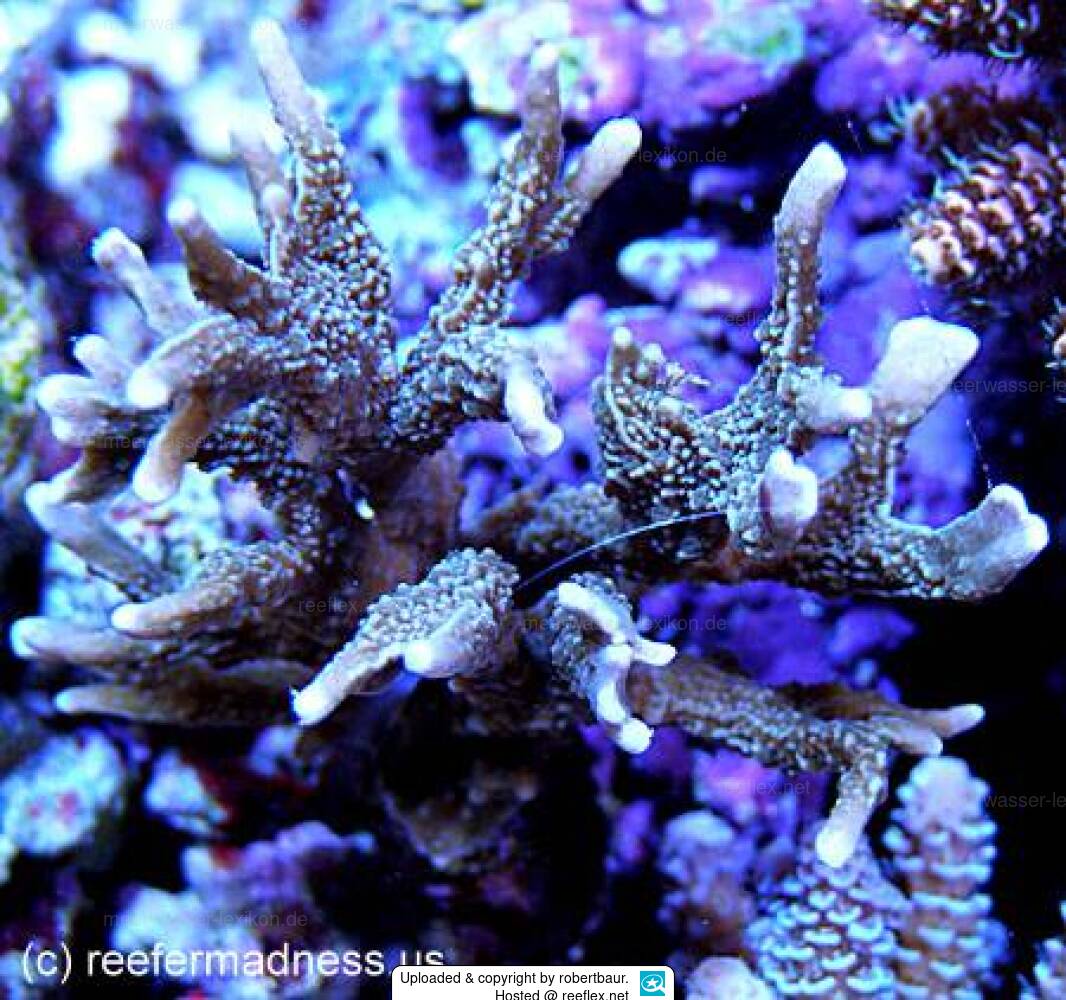Info
Montipora stellata
Bernard, 1897
Characters: Colonies are small, composed of contorted laminae sometimes in whorls or tiers and upright contorted branches which are irregularly fused. Corallites are immersed with irregular thecal papillae. Coenosteum papillae are numerous and are infrequently fused into ridges.
General:
Taxonomists today assume 18 families of stony corals with a total of over 100 genera. The two genera Montipora (over 70 species - Veron 2000) and Acropora (over 180 species - Veron 2000) are among the most numerous and species-rich.
Stony corals are reef-building invertebrates living in the world's oceans, sessile and colony-forming cnidarians that form a calcareous skeleton.
They live mainly on light via their zooxanthellae, but are also able to catch plankton with their polyps.
They extract calcium and, to a lesser extent, other elements from the seawater, producing several grams of calcium carbonate per day, which is how they formed the coral reefs we know today.
The species of the genus Montipora, like Acropora corals, are also often very colourful and their long-term, successful keeping has been considered a high art for many years.
They have been kept in aquariums since the end of the 1980s and were even widely bred in the 1990s.
Keeping and asexual propagation via offshoots quickly became popular, which is why today private aquarists offer coral offshoots in addition to commercial breeders.
The care of small polyped stony corals was and is usually far more complex than that of most LPS corals and zooxanthellate soft corals due to the requirements of the corals for water quality and lighting.
Therefore also only with the possibilities of the skimming and the use of live rock a better water quality came about, as well as by a better lighting and a better calcium supply the durable attitude and propagation on.
Since keeping SPS corals became an attainable goal for many, zooxanthellate soft corals are hardly the main focus of most aquarists.
Identification of small-polyped and large-polyped stony corals is not always easy, despite really good works such as Veron's book, Corals of the World - especially since definite identification would actually be based on the calcium skeleton or DNA analysis.
One should also not forget that many animals in the aquarium do not look like they do in nature and change their appearance due to current, light as well as other influences.
Among the important parameters:
Light:
All small polyp stony corals from the genus Montipora require very high light intensity.
Therefore, they should rather be located at the top of the tank with average lighting.
Heat/Cold:
Corals of the genus Montipora will not tolerate water temperatures below 20 degrees or above 30 degrees for extended periods.
Both cases they will acknowledge with bleaching.
Current:
They can tolerate a fair amount of current, although the pump outlet should never be aimed directly at a coral.
Alternating, more turbulent flow conditions are best.
Water parameters:
Trace elements, (calcium 420-440 mg/L, magnesium 1100-1300 mg/L, KH below 8, strontium 8 mg/L). Water changes: at least 5% a week or 10% a month.
Water quality:
Permanently stable and clear water if possible; if necessary, carbon filtration or ozonation is advisable to remove yellow substances.
The bucket comparison (white containers of the same size, in one bucket freshly prepared water, in the other bucket aquarium water) will quickly show you if your water in the aquarium is as clear as fresh water.
Acropora stony corals do not like to stand in a yellow broth.
Nitrate NO3:
Less than 5 mg/L.
Phosphate PO4:
Less than 0.1 mg/L better even in the range of 0.01 mg/L.
While large polyp stony corals usually still manage with higher nutrient values, certain Montipora corals sometimes show a loss of color, or the growth of the animals is partially disturbed.
Corals that used to be colorful then quickly turn into an often unsightly brown.
The reason for this is the higher supply of nutrients.
The more nutrients, the more zooxanthellae are formed and the darker the animal will become.
If there is a long-term oversupply or imbalance of nutrients, tissue dissolution can occur.
Now this does not affect all Montipora species, as there are definitely some that are considered beginner corals, as they can still handle higher nitrate levels.
Last but not the least:
Let's not forget the aspect of animal and environmental protection, which all coral breeders are doing by now.
The more offshoots, the less removals in nature.
Fortunately there has been a lot of change in the last years.
So today corals from aquaculture are offered preferentially and sold as offspring.
Bernard, 1897
Characters: Colonies are small, composed of contorted laminae sometimes in whorls or tiers and upright contorted branches which are irregularly fused. Corallites are immersed with irregular thecal papillae. Coenosteum papillae are numerous and are infrequently fused into ridges.
General:
Taxonomists today assume 18 families of stony corals with a total of over 100 genera. The two genera Montipora (over 70 species - Veron 2000) and Acropora (over 180 species - Veron 2000) are among the most numerous and species-rich.
Stony corals are reef-building invertebrates living in the world's oceans, sessile and colony-forming cnidarians that form a calcareous skeleton.
They live mainly on light via their zooxanthellae, but are also able to catch plankton with their polyps.
They extract calcium and, to a lesser extent, other elements from the seawater, producing several grams of calcium carbonate per day, which is how they formed the coral reefs we know today.
The species of the genus Montipora, like Acropora corals, are also often very colourful and their long-term, successful keeping has been considered a high art for many years.
They have been kept in aquariums since the end of the 1980s and were even widely bred in the 1990s.
Keeping and asexual propagation via offshoots quickly became popular, which is why today private aquarists offer coral offshoots in addition to commercial breeders.
The care of small polyped stony corals was and is usually far more complex than that of most LPS corals and zooxanthellate soft corals due to the requirements of the corals for water quality and lighting.
Therefore also only with the possibilities of the skimming and the use of live rock a better water quality came about, as well as by a better lighting and a better calcium supply the durable attitude and propagation on.
Since keeping SPS corals became an attainable goal for many, zooxanthellate soft corals are hardly the main focus of most aquarists.
Identification of small-polyped and large-polyped stony corals is not always easy, despite really good works such as Veron's book, Corals of the World - especially since definite identification would actually be based on the calcium skeleton or DNA analysis.
One should also not forget that many animals in the aquarium do not look like they do in nature and change their appearance due to current, light as well as other influences.
Among the important parameters:
Light:
All small polyp stony corals from the genus Montipora require very high light intensity.
Therefore, they should rather be located at the top of the tank with average lighting.
Heat/Cold:
Corals of the genus Montipora will not tolerate water temperatures below 20 degrees or above 30 degrees for extended periods.
Both cases they will acknowledge with bleaching.
Current:
They can tolerate a fair amount of current, although the pump outlet should never be aimed directly at a coral.
Alternating, more turbulent flow conditions are best.
Water parameters:
Trace elements, (calcium 420-440 mg/L, magnesium 1100-1300 mg/L, KH below 8, strontium 8 mg/L). Water changes: at least 5% a week or 10% a month.
Water quality:
Permanently stable and clear water if possible; if necessary, carbon filtration or ozonation is advisable to remove yellow substances.
The bucket comparison (white containers of the same size, in one bucket freshly prepared water, in the other bucket aquarium water) will quickly show you if your water in the aquarium is as clear as fresh water.
Acropora stony corals do not like to stand in a yellow broth.
Nitrate NO3:
Less than 5 mg/L.
Phosphate PO4:
Less than 0.1 mg/L better even in the range of 0.01 mg/L.
While large polyp stony corals usually still manage with higher nutrient values, certain Montipora corals sometimes show a loss of color, or the growth of the animals is partially disturbed.
Corals that used to be colorful then quickly turn into an often unsightly brown.
The reason for this is the higher supply of nutrients.
The more nutrients, the more zooxanthellae are formed and the darker the animal will become.
If there is a long-term oversupply or imbalance of nutrients, tissue dissolution can occur.
Now this does not affect all Montipora species, as there are definitely some that are considered beginner corals, as they can still handle higher nitrate levels.
Last but not the least:
Let's not forget the aspect of animal and environmental protection, which all coral breeders are doing by now.
The more offshoots, the less removals in nature.
Fortunately there has been a lot of change in the last years.
So today corals from aquaculture are offered preferentially and sold as offspring.







 robertbaur
robertbaur
















































































